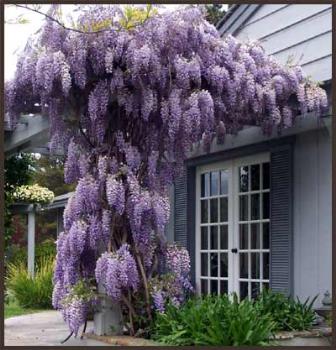Wisteria
By frankiecesca
@frankiecesca (2489)
July 24, 2009 5:51am CST
I am trying to grow some Wisteria plant up an archway that is over a bench in my garden - it has not really grown that much even though thr label stated that it can be grown in full or partial sun. One side of the arch is partial sun and the other is full sun but, it still doesn't seem to be growing a lot at all - do any mylotters have any tips on growing this plant that could help me to get it to grow quickly over my archway? x
2 people like this
2 responses
@mari61960 (4893)
• United States
24 Jul 09
Here is what I know...Wisteria are vigorous, twining vines with wide landscape usage where space permits and gardeners are committed to keeping them in bounds. Among their attributes are hardiness, vigor, longevity and the ability to climb high. They are greatly valued for their large, pendulous flower clusters that occur in the spring. Flowers are pea-like and may be white, pink, lilac-blue, bluish-purple or purple in color. The fruit is a long, green flattened pod that is not particularly ornamental. The plant climbs by means of twining stems and has alternate, pinnately compound leaves. Older, established plants may have a twisted, woody trunk several inches in diameter. Plants that have been grown from seed remain in a long juvenile stage and often do not bloom for 10 to 15 years or longer. Plants that are grafted, and plants grown from cuttings or layered from a flowering plant will usually begin flowering earlier than seedlings.
In order to bloom well, wisteria require full sun (six or more hours of direct sun per day) and a deep, moderately fertile, moist soil that does not dry out excessively. They will adapt to most soils, though they prefer a neutral to slightly acid soil pH of 6.0-7.0 for best results.
Good site preparation will help ensure plant establishment. Begin with a soil test to determine if the soil pH or the phosphorus level need correction. If so, make additions of materials as you are preparing the soil. Prepare soil in an area two to three feet in diameter and 18 to 24 inches deep. Mix into the native soil either peat moss, compost or well rotted manure, one-third by volume, to improve soil aeration and drainage.
Once the soil is prepared and the support system is in place, the vine can be planted. Place the root ball of the plant in the hole so it is no deeper than it originally grew in the nursery. Fill in the hole with the prepared soil mix and firm it around the root ball. Water well after planting, soaking the entire area. ** New plants will require an inch of water per week applied either through irrigation or as rainfall. Young plants should be fertilized annually until they fill the allotted space. Do not expect young vines to bloom since vegetative growth is being encouraged. Once the plant is established and has filled the allotted space, do not fertilize unless shoot and foliage growth and color is not good. Water only if foliage wilts as it might during drought conditions. Both of these practices stimulate vegetative growth and limit flower production.
A plant will also fail to bloom if: it does not receive full sunlight; there is excessive vegetative growth that may have been stimulated by excess nitrogen fertilizer; it is pruned heavily in winter and spring, which encourages vigorous, vegetative growth; and/or it is pruned improperly.
I don't know anyone who has had blooms before 5years but I believe the average to be 7year till first bloom... that's why I have never planted them.. of course by now I would have tons of blooms... I am impatient like that, just can't wait..lol
Here is a link to some information that may be helpful.
http://countrylife.lehmans.com/2009/01/15/how-to-care-for-wisteria-plant/
@puddytat101 (657)
• United States
4 Aug 09
To train plants on a wire trellis or an arbor, select a vigorous, upright stem to serve as the main vine and attach this to the support. Remove other side shoots. As the main vine grows, side branches will develop and produce more shoots as the flower buds. Continue to train the main vine upward and the new side branches as needed to form a framework. Pinch off the main vine when it reaches the desired height.
Did you know?
Wisteria is a member of the pea family!







